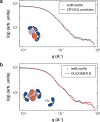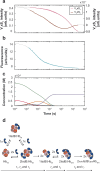Time-resolved X-ray solution scattering unveils the events leading to hemoglobin heme capture by staphylococcal IsdB
- PMID: 39962089
- PMCID: PMC11832919
- DOI: 10.1038/s41467-024-54949-w
Time-resolved X-ray solution scattering unveils the events leading to hemoglobin heme capture by staphylococcal IsdB
Abstract
Infections caused by Staphylococcus aureus depend on its ability to acquire nutrients. One essential nutrient is iron, which is obtained from the heme of the human host hemoglobin (Hb) through a protein machinery called Iron-regulated surface determinant (Isd) system. IsdB is the protein in charge of heme extraction from Hb, which is the first step of the chain of events leading to iron transfer to the bacterium cell interior. In order to elucidate the molecular events leading from the formation of the initial IsdB:Hb complex to heme extraction, we use time-resolved X-ray solution scattering (TR-XSS) in combination with rapid mixing triggering. We succeed in defining the stoichiometry of IsdB:Hb binding and in describing the kinetics of the subsequent structural changes. The presented approach is potentially applicable to unveil the complex kinetic pathways generated by protein-protein interaction in different biological systems.
© 2024. The Author(s).
Conflict of interest statement
Competing interests: The authors declare no competing interests.
Figures






Similar articles
-
Structure-function analyses reveal key features in Staphylococcus aureus IsdB-associated unfolding of the heme-binding pocket of human hemoglobin.J Biol Chem. 2018 Jan 5;293(1):177-190. doi: 10.1074/jbc.M117.806562. Epub 2017 Nov 6. J Biol Chem. 2018. PMID: 29109153 Free PMC article.
-
Unique heme-iron coordination by the hemoglobin receptor IsdB of Staphylococcus aureus.Biochemistry. 2011 Jun 21;50(24):5443-52. doi: 10.1021/bi200369p. Epub 2011 May 26. Biochemistry. 2011. PMID: 21574663 Free PMC article.
-
Staphylococcus aureus IsdB is a hemoglobin receptor required for heme iron utilization.J Bacteriol. 2006 Dec;188(24):8421-9. doi: 10.1128/JB.01335-06. Epub 2006 Oct 13. J Bacteriol. 2006. PMID: 17041042 Free PMC article.
-
Structural biology of heme binding in the Staphylococcus aureus Isd system.J Inorg Biochem. 2010 Mar;104(3):341-8. doi: 10.1016/j.jinorgbio.2009.09.012. Epub 2009 Sep 26. J Inorg Biochem. 2010. PMID: 19853304 Review.
-
Iron-regulated surface determinants (Isd) of Staphylococcus aureus: stealing iron from heme.Microbes Infect. 2004 Apr;6(4):390-7. doi: 10.1016/j.micinf.2003.12.008. Microbes Infect. 2004. PMID: 15101396 Review.
Cited by
-
Photodynamic therapeutic activity of novel porphyrins against lung squamous cell carcinoma.BMC Cancer. 2025 May 28;25(1):960. doi: 10.1186/s12885-025-14386-4. BMC Cancer. 2025. PMID: 40437394 Free PMC article.
References
MeSH terms
Substances
Grants and funding
- IH-LS-3074 and LS-2807/European Synchrotron Radiation Facility (ESRF)
- PRIN 2020AE3LTA/Ministero dell'Istruzione, dell'Università e della Ricerca (Ministry of Education, University and Research)
- PRIN 2022RCP52Y/Ministero dell'Istruzione, dell'Università e della Ricerca (Ministry of Education, University and Research)
- Scientific Equipment Fund 2018/Università degli Studi di Parma (University of Parma)
LinkOut - more resources
Full Text Sources

